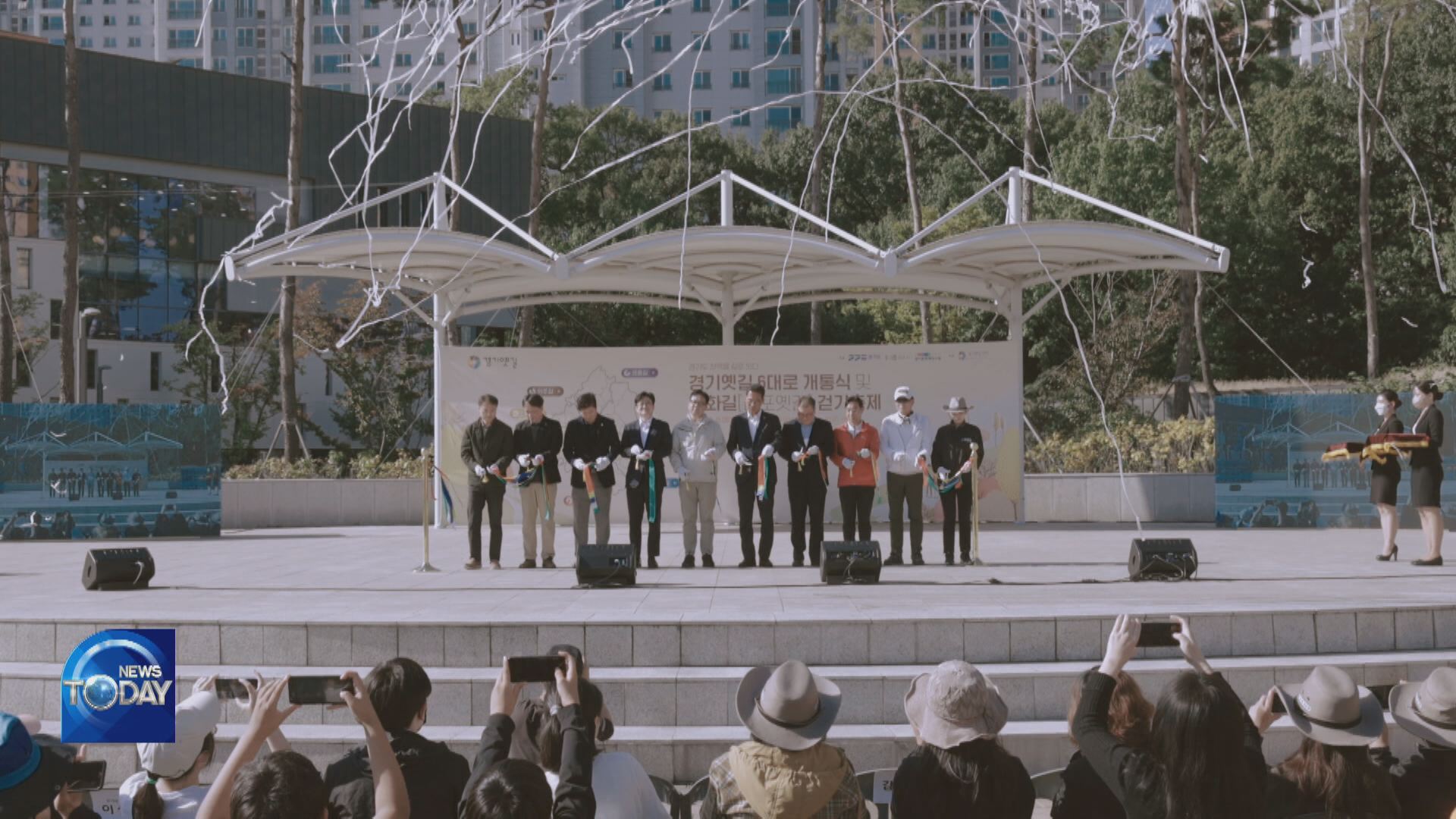OPENING OF OLD GIMPO ROAD
입력 2022.10.27 (15:03)
수정 2022.10.27 (16:45)
읽어주기 기능은 크롬기반의
브라우저에서만 사용하실 수 있습니다.
[Anchor Lead]
The GyeongGi Cultural Foundation started building the old Gyeonggi roads in 2013. Now its last segment, Ganghwa road, also called the old Gimpo road, has opened. Let's travel through the 52-kilometer course.
[Pkg]
The Ara Gimpo Passenger Terminal is not far from where cargo vessels used to travel in the Joseon period. Ganghwa road or Old Gimpo Road that starts at this point has opened recently. It is the last section to be completed out of the six old Gyeonggi roads to be built based on an old map.
[Soundbite] Park Bu-won(Researcher, Gyeonggi Cultural Foundation) : "It was the logistic center of the Hangang River region and also a key traffic route for capital defense."
The first segment of Cheondeung Road is connected to the Geumneung segment, where Jangneung is located. Jangneung is where King Injo's father is laid to rest. Visitors then arrive at Gimpo Hyanggyo, a Confucian school that remains at the center of old Gimpo city where public offices used to be. The old Goguryeo-era name for Gimpo was Geompo, meaning a sacred port village. Then the name was changed to Gimpo during the Unified Silla period.
[Soundbite] Kim Byung-soo(Gimpo Mayor) : "The old Gimpo trails from Cheondeung Road to Hannam Arterial Road are precious gift for our children. I hope many citizens come to feel the sentiments of the old Gimpo roads."
About two kilometers away is Gimpo Central Park, a relaxing spot for Gimpo residents. Also nearby is Gimpo Art Village where visitors can have various experiences and enjoy great food at the hanok village. Visitors can walk through the Unyang Ferry Route, where Gimpo Han River Wild Bird Ecological Park is located, to reach Ganghwa Bridge in the Hannam Arterial Road at the end of the 52-kilometer-long old Gimpo trail. Since the last segment opened about a week ago, roughly 70 people have walked the entire old Gyeonggi trails to leave their names in the Hall of Fame.
The GyeongGi Cultural Foundation started building the old Gyeonggi roads in 2013. Now its last segment, Ganghwa road, also called the old Gimpo road, has opened. Let's travel through the 52-kilometer course.
[Pkg]
The Ara Gimpo Passenger Terminal is not far from where cargo vessels used to travel in the Joseon period. Ganghwa road or Old Gimpo Road that starts at this point has opened recently. It is the last section to be completed out of the six old Gyeonggi roads to be built based on an old map.
[Soundbite] Park Bu-won(Researcher, Gyeonggi Cultural Foundation) : "It was the logistic center of the Hangang River region and also a key traffic route for capital defense."
The first segment of Cheondeung Road is connected to the Geumneung segment, where Jangneung is located. Jangneung is where King Injo's father is laid to rest. Visitors then arrive at Gimpo Hyanggyo, a Confucian school that remains at the center of old Gimpo city where public offices used to be. The old Goguryeo-era name for Gimpo was Geompo, meaning a sacred port village. Then the name was changed to Gimpo during the Unified Silla period.
[Soundbite] Kim Byung-soo(Gimpo Mayor) : "The old Gimpo trails from Cheondeung Road to Hannam Arterial Road are precious gift for our children. I hope many citizens come to feel the sentiments of the old Gimpo roads."
About two kilometers away is Gimpo Central Park, a relaxing spot for Gimpo residents. Also nearby is Gimpo Art Village where visitors can have various experiences and enjoy great food at the hanok village. Visitors can walk through the Unyang Ferry Route, where Gimpo Han River Wild Bird Ecological Park is located, to reach Ganghwa Bridge in the Hannam Arterial Road at the end of the 52-kilometer-long old Gimpo trail. Since the last segment opened about a week ago, roughly 70 people have walked the entire old Gyeonggi trails to leave their names in the Hall of Fame.
■ 제보하기
▷ 카카오톡 : 'KBS제보' 검색, 채널 추가
▷ 전화 : 02-781-1234, 4444
▷ 이메일 : kbs1234@kbs.co.kr
▷ 유튜브, 네이버, 카카오에서도 KBS뉴스를 구독해주세요!
- OPENING OF OLD GIMPO ROAD
-
- 입력 2022-10-27 15:03:21
- 수정2022-10-27 16:45:36

[Anchor Lead]
The GyeongGi Cultural Foundation started building the old Gyeonggi roads in 2013. Now its last segment, Ganghwa road, also called the old Gimpo road, has opened. Let's travel through the 52-kilometer course.
[Pkg]
The Ara Gimpo Passenger Terminal is not far from where cargo vessels used to travel in the Joseon period. Ganghwa road or Old Gimpo Road that starts at this point has opened recently. It is the last section to be completed out of the six old Gyeonggi roads to be built based on an old map.
[Soundbite] Park Bu-won(Researcher, Gyeonggi Cultural Foundation) : "It was the logistic center of the Hangang River region and also a key traffic route for capital defense."
The first segment of Cheondeung Road is connected to the Geumneung segment, where Jangneung is located. Jangneung is where King Injo's father is laid to rest. Visitors then arrive at Gimpo Hyanggyo, a Confucian school that remains at the center of old Gimpo city where public offices used to be. The old Goguryeo-era name for Gimpo was Geompo, meaning a sacred port village. Then the name was changed to Gimpo during the Unified Silla period.
[Soundbite] Kim Byung-soo(Gimpo Mayor) : "The old Gimpo trails from Cheondeung Road to Hannam Arterial Road are precious gift for our children. I hope many citizens come to feel the sentiments of the old Gimpo roads."
About two kilometers away is Gimpo Central Park, a relaxing spot for Gimpo residents. Also nearby is Gimpo Art Village where visitors can have various experiences and enjoy great food at the hanok village. Visitors can walk through the Unyang Ferry Route, where Gimpo Han River Wild Bird Ecological Park is located, to reach Ganghwa Bridge in the Hannam Arterial Road at the end of the 52-kilometer-long old Gimpo trail. Since the last segment opened about a week ago, roughly 70 people have walked the entire old Gyeonggi trails to leave their names in the Hall of Fame.
The GyeongGi Cultural Foundation started building the old Gyeonggi roads in 2013. Now its last segment, Ganghwa road, also called the old Gimpo road, has opened. Let's travel through the 52-kilometer course.
[Pkg]
The Ara Gimpo Passenger Terminal is not far from where cargo vessels used to travel in the Joseon period. Ganghwa road or Old Gimpo Road that starts at this point has opened recently. It is the last section to be completed out of the six old Gyeonggi roads to be built based on an old map.
[Soundbite] Park Bu-won(Researcher, Gyeonggi Cultural Foundation) : "It was the logistic center of the Hangang River region and also a key traffic route for capital defense."
The first segment of Cheondeung Road is connected to the Geumneung segment, where Jangneung is located. Jangneung is where King Injo's father is laid to rest. Visitors then arrive at Gimpo Hyanggyo, a Confucian school that remains at the center of old Gimpo city where public offices used to be. The old Goguryeo-era name for Gimpo was Geompo, meaning a sacred port village. Then the name was changed to Gimpo during the Unified Silla period.
[Soundbite] Kim Byung-soo(Gimpo Mayor) : "The old Gimpo trails from Cheondeung Road to Hannam Arterial Road are precious gift for our children. I hope many citizens come to feel the sentiments of the old Gimpo roads."
About two kilometers away is Gimpo Central Park, a relaxing spot for Gimpo residents. Also nearby is Gimpo Art Village where visitors can have various experiences and enjoy great food at the hanok village. Visitors can walk through the Unyang Ferry Route, where Gimpo Han River Wild Bird Ecological Park is located, to reach Ganghwa Bridge in the Hannam Arterial Road at the end of the 52-kilometer-long old Gimpo trail. Since the last segment opened about a week ago, roughly 70 people have walked the entire old Gyeonggi trails to leave their names in the Hall of Fame.
이 기사가 좋으셨다면
-
좋아요
0
-
응원해요
0
-
후속 원해요
0

















이 기사에 대한 의견을 남겨주세요.